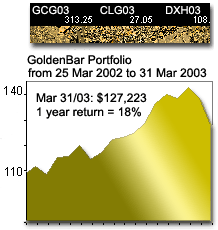 Daily
Global Market Outlook
Daily
Global Market Outlook
POG Correction Almost Over
12 February 2003
a currency & gold market analysis
by Ed Bugos
| Print Copy | ||
| Today's Highlights: | ||
| War confusion and Silver, Yen action boost dollar/gold |  |
|
| Two economic consequences of Bush's tax plan, not the budget | ||
| Gold shares appear headed for 200-day | ||
| Anglo's playing with fire by waiting... or did they know something? | ||
| New perspective at Barrick | ||
| Goldcorp announces good news in a tough market | ||
| Yen weakening speculation mounts | ||
The United States is now on orange plus alert. There was actually no change to the alert status from orange last week, but reacting to reported threats by Al Qaeda, Washington deployed heat seeking Stinger missiles around the Capital. Increasing concern over North Korea and an audio tape by Osama bin Laden crying out for Muslims to fight the "allies of the devil" prompted the action.
Fund selling was blamed for gold's weakness Wednesday. Presumably in anticipation of further sales on the TOCOM exchange in Japan Thursday morning - Japan's markets reopened from a holiday Wednesday morning to find lower gold prices. It was a classic shakeout.
The pundits explained gold's pullback as originating from the idea the US war on Iraq has been postponed. Hogwash. Bush doesn't need NATO or the UN as he's already threatened them to be on the verge of irrelevancy. You heard right. The fact that the world protests against this war is of no consequence to GW. I guess he really wants to get into Iraq before April.
I suspect that the most bearish influence on gold prices came from what happened to silver. Silver futures got clobbered. The bears took out important short term trend support at $4.60 on the nearest contract and drove prices down to an intraday low of $4.49 - well below the 200 day moving average, which is at $4.68 today. Selling was seen out of the India's industrial sector. But the intermediate and primary trends remained neutral.
A deflation wind (gas?) swept through US markets Wednesday nevertheless, as the dollar made new short term highs the day before and closed a might higher Wednesday also (though it didn't translate into a higher high).
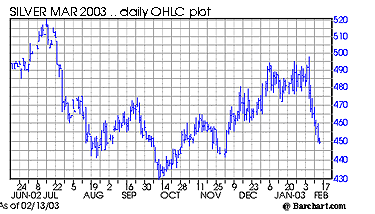 There
aren't any bullish footprints on the dollar index chart yet, but the weakness
in gold prices suggested they were coming.
There
aren't any bullish footprints on the dollar index chart yet, but the weakness
in gold prices suggested they were coming.
Cocoa was the only commodity that showed gains Wednesday. The rest were off 1 to 2 percent and pulled the commodity indexes down by about the same amount - 1%.
Undoubtedly this weighed on the gold trade and strengthened the tone of the dollar in F/X markets.
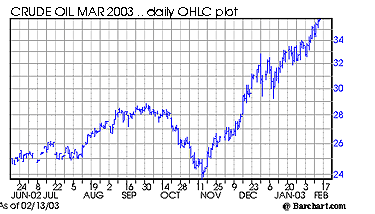 Oil
prices fell back a little in Europe, but were supported by bullish inventory
data. Oil inventories dropped by about 4 million barrels for the week
ending Feb 7th to their lowest levels since 1975. Mostly they fell in
the Gulf Coast and Midwest (PADD II and III) regions. NYMEX Crude raced
off to new highs ($35.95).
Oil
prices fell back a little in Europe, but were supported by bullish inventory
data. Oil inventories dropped by about 4 million barrels for the week
ending Feb 7th to their lowest levels since 1975. Mostly they fell in
the Gulf Coast and Midwest (PADD II and III) regions. NYMEX Crude raced
off to new highs ($35.95).
After trying to discount the best case war scenario earlier this week and then Greenspan's bullish inference for the economy - that it isn't necessary to lower rates further - stock prices fell further towards their October, and 1998, lows. Bond yields fell lower both Tuesday and Wednesday after climbing Monday, also despite Greenspan's remarks about the budget - that once debt to GDP begins to rise, there's just no self correcting mechanism, the debt just continues to rise - as well as his support of Bush's tax plan on dividends.

Don't take this wrong. We fully support any tax reduction schemes, and are highly skeptical of the charge that any such reductions are bearish for the budget. However, there are two potential side affects of Bush's (dividend tax) plan the market probably isn't considering at the moment. The first is that the incentive will go to paying out higher dividends in order to boost stock values at the expense of business spending by companies. The second is the effect on the relationship between stocks and bonds as the budget deficit is already set to grow.
The case for higher interest rates/yields is already strong on account of the inflation argument (dollar weakness and strong commodity prices), the current account deficit, as well as the future of the government's intensifying overseas borrowing needs. But the favorable tax treatment for stock dividends could exaggerate the decoupled nature of equities and fixed income markets that has been in place since 1998.
In short, the plan could backfire.
No wonder Greenspan supports it. I'm kidding under the assumption he doesn't like Bush much, or at least not as much as Clinton.
Anyhow, Bush's team has claimed that there is no link between higher budget deficits and interest rates. To an extent this is true I think, but not while the dollar's weak.
Speaking of which, we happen to think gold is a bargain again. Undoubtedly there is concern that a falling stock market will produce deflation, but that's just perfect for creating buying opportunities in the metal.
Gold stocks fell back after Tuesday's sharp rally, but although those gains were wiped out, prices didn't fall below Tuesday's lows on average.
Nonetheless, our outlook for gold shares is still cautious - see last week's issue - in the short term, but our outlook for the metal is brighter now after a $40 pullback in only a week! Sure, we might see further weakness Thursday, but our view is that a bear market on Wall Street continues to be bearish for the dollar's liquidity (investment) premium. The dollar's bounce at around this level was expected, but to be frank, it's not as bullish a bounce as I'd expected would be the case anyway.
Certainly, this war nonsense has thrown a bombshell of confusion at the markets, and our outlook for gold and oil has to adapt to it. What I mean is that the media driven war focus brings in the weak hands that have been conditioned to speculate on the immediacy of war, almost to the neglect of the fundamental outlook for the dollar, as well as gold and oil. The result is volatility and of course, opportunity. Bear Sterns said it right when they described the war premium in gold at the margin.
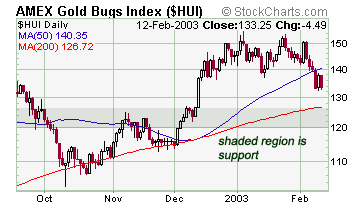 Last
year we said that whenever the peace trade (sentiment) inflates, investors
should buy the dip in oil. Now that gold has been put in play at the margin,
the same applies there, at least until our fundamental outlook for higher
gold values changes.
Last
year we said that whenever the peace trade (sentiment) inflates, investors
should buy the dip in oil. Now that gold has been put in play at the margin,
the same applies there, at least until our fundamental outlook for higher
gold values changes.
When we wrote our top five gold stocks issue in January, our confidence wasn't great in the timing of an initial entry position. It's getting better. If I had to speculate on a short term bottom for the gold stocks, I'd say it will happen at about 120 to 125 for the AMEX Gold Bugs index, which is about another 5 to 10 percent lower. The average gold stock is likely to be more volatile than this index of course. Ranking the timeliness of an initial entry position in gold stocks on a scale between 1 and 5 (1 being most timely), I'd say subjectively that it is still a two, but that as we approach the aforementioned levels in the HUI it would become a "one."
If the Dow is going to new lows, I feel confident that the outlook for gold prices will increasingly strengthen, and broaden.
At any rate, the dip in gold prices is likely to bring in the hedgers once again after they refused buying the last 20 point gain in gold prices on their way to $390. You'll see what I mean in a minute...
Still the Second Largest Hedge Book
in the World
Dear Bobby Godsell (Anglogold
CEO),
If you think Anglogold's shares doubled during 2002 because it's the world's second biggest gold company (Newmont is arguably number one today), guess again. The company's shares gained for one reason only - its commitment to reduce the hedge book. Don't lose sight of that, and don't let this happen to your stock:

Indeed, Anglo's stock has performed exceptionally well relative to its blue chip peers. It was the only blue chip producer that broke out to new highs in the latest gold rally - December/January.
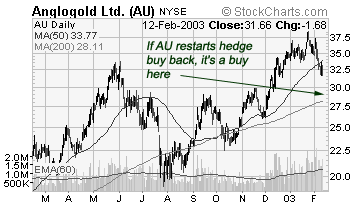 If
you're willing to accept that companies like Barrick have the equivalent
of a risk premium priced into their stock in lieu of their bearish hedge
position, imagine what might happen to the price of their shares if management
decided to liquidate the liability in a bull market (gold) - the stock
wouldn't only go up, it would probably outperform its peers. There's extra
leverage. Not only would the bottom line then fall more in line with gold
price moves and flow more directly through to shareholders, but also,
valuations could then recover to where the unhedged values already are.
If
you're willing to accept that companies like Barrick have the equivalent
of a risk premium priced into their stock in lieu of their bearish hedge
position, imagine what might happen to the price of their shares if management
decided to liquidate the liability in a bull market (gold) - the stock
wouldn't only go up, it would probably outperform its peers. There's extra
leverage. Not only would the bottom line then fall more in line with gold
price moves and flow more directly through to shareholders, but also,
valuations could then recover to where the unhedged values already are.
This is what I think was happening in Anglo's market during 2002. The market began pricing it in the direction of a real gold company under the assumption it would continue reducing its hedges. Godsell has been loud enough about it after all.
Anglo's hedge book had as much as 19 million ounces of gold committed during 2000. That was three years worth of production and almost a third of their reserves - proven & probable. Today there is little more than 11 million ounces committed. Most of the hedges were bought back, but some were delivered into.
It's still the second largest hedge book in the world, preceded only by Barrick. Moreover, Anglo still has the largest marked to market cash drain on its books.
However, it also boasted among the most aggressive hedge buyback plans during 2002. Newmont, Placer, and Barrick on the other hand are ho-humming along like deer stuck in headlights (that may change at Barrick now???).
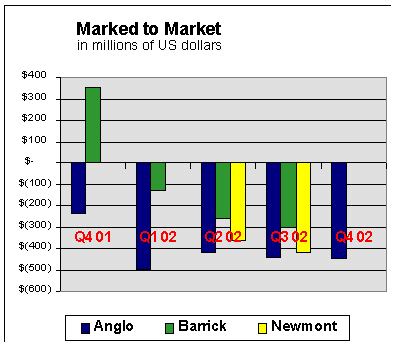 Anglo
has advertised its commitment to shareholders, that it would reverse its
hedges now that it's become bullish on gold. Consequently, and this I
think is very important, the marked-to-market loss on their hedge
position stabilized throughout last year while others' worsened
(we haven't got NEM and ABX hedge data for the fourth quarter yet but
trend has deteriorated all year long).
Anglo
has advertised its commitment to shareholders, that it would reverse its
hedges now that it's become bullish on gold. Consequently, and this I
think is very important, the marked-to-market loss on their hedge
position stabilized throughout last year while others' worsened
(we haven't got NEM and ABX hedge data for the fourth quarter yet but
trend has deteriorated all year long).
Barrick's hedge book was worth a "positive" US$356 million at the end of 2001. In the third quarter it was worth a negative US$300 million (see chart). That's almost a US$700 million bearish swing in three quarters. Newmont acquired its hedges during the first and second quarter - what a deal. And while Anglo's hedge book deteriorated compared to the fourth quarter of 2001, it stopped deteriorating shortly thereafter. We attribute that wholly to the company's buyback program!
However, in its fourth quarter report, Anglo also said that the marked to market value of its hedges declined to a negative US$590 million by the end of January from a negative US$447 million at the end of December - where they largely stabilized through 2002. Thus, while this value stabilized all year long during 2002 on a $40 gain in the price of gold, in only one month it deteriorated by almost 35% on a $20 gain in the price of gold. What happened?
They stopped buying back their hedges, obviously. Maybe they expected this dip. Or maybe they've turned bearish. Maybe they wanted to see how the market would do without them buying it up every other day. Choo-o-o-o, Choo--o-o! That's the sound of the train as it left the station. Blew right by them. Gold prices kept charging higher without them.
I think you get the point Mr. Godsell. Don't try and outguess the market. There's too much at stake. If Anglo is fundamentally bullish, there's no reason to be hedged whatsoever. The gold market is liquid. Buy back 5 million ounces this year and be done with it - and watch your stock go to the moon. Or crash and burn with Barrick. The same message goes out to Wayne Murdy of Newmont. Be bullish, as Merrill Lynch would say!
A copy of the complete story in today's Daily Global Market Outlook is available to subscribers through Goldenbar.com